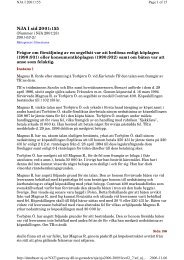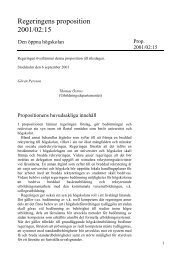A Study of the ITU-T G.729 Speech Coding Algorithm ...
A Study of the ITU-T G.729 Speech Coding Algorithm ...
A Study of the ITU-T G.729 Speech Coding Algorithm ...
You also want an ePaper? Increase the reach of your titles
YUMPU automatically turns print PDFs into web optimized ePapers that Google loves.
Open<br />
MASTER THESIS<br />
Datum - Date Rev Dokumentnr - Document no.<br />
04-09-28 PA1<br />
• Robustness Against Channel Errors<br />
There are two types <strong>of</strong> channel errors. The first one is random errors which occur<br />
as a consequence <strong>of</strong> channel noise. This is specified as Bit Error Rate (BER). The<br />
counter-measure against random errors is channel coding. In channel coding, redundancies<br />
are added to <strong>the</strong> signal to make it more robust against channel errors.<br />
The second type <strong>of</strong> channel errors are called burst errors. These errors are common<br />
in radio channels and occur due to causes like, for instance, fading. In order to fight<br />
burst errors, detection schemes are implemented.<br />
2.5 <strong>Speech</strong> <strong>Coding</strong> Techniques<br />
Figure 10 demonstrates one way <strong>of</strong> classifying speech coders according to coding method<br />
and domain [13]. In <strong>the</strong> figure, <strong>the</strong> bit-rate increases to <strong>the</strong> right, i.e. vocoders have <strong>the</strong><br />
lowest bit-rate and waveform coders <strong>the</strong> highest. The downward pointing arrow on <strong>the</strong><br />
left corresponds to coding in time-domain while <strong>the</strong> arrow on <strong>the</strong> right points to coding<br />
techniques in frequency domain.<br />
In <strong>the</strong> following text <strong>the</strong> four different speech coder types are explained. Last in this<br />
section, a table <strong>of</strong> speech-coding standards and <strong>the</strong>ir characteristics is provided.<br />
2.5.1 Waveform Coders<br />
Figure 10: <strong>Speech</strong> coding techniques<br />
The world’s first speech coding standard, <strong>the</strong> G.711 64kbit/s PCM, is a waveform coder.<br />
Waveform coders faithfully attempt to preserve <strong>the</strong> time domain waveform. Thus, waveform<br />
coders performs as well on non-speech signals.<br />
The waveform coders are <strong>the</strong> best coders with regard to speech quality, however, with<br />
<strong>the</strong> downside <strong>of</strong> a high bit-rate. The simplest waveform coding technique is PCM. More<br />
advanced techniques are used in Adaptive Delta Modulation (ADM), Adaptive Differential<br />
Pulse Code Modulation (ADPCDM), Pitch-Predictive Differential Pulse Code Modulation<br />
(PPDPCM) and Adaptive Predictive <strong>Coding</strong> (APC). For fur<strong>the</strong>r information on waveform<br />
coders <strong>the</strong> reader may, for example, consult [13].<br />
26 (78)





